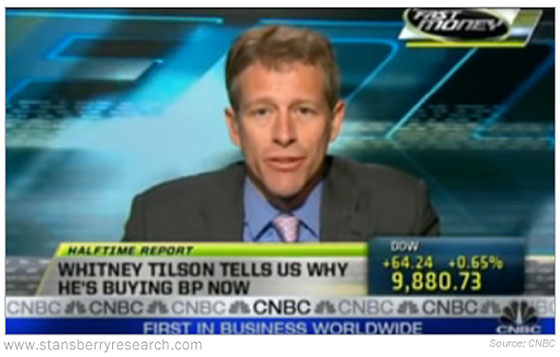Send this article to a friend:
April
18
2019

Send this article to a friend: April |
 |
How to Make Your “Embarrassing” Investments Pay Off
|
 |
Whitney Tilson on CNBC’s Fast Money
BP deserved the anger and blame. But when it came to the company’s future, the crowd was just flat-out wrong. Here’s what I told viewers that day…
What everybody’s missing here is this is truly one of the most profitable businesses on the planet. They have managed to screw everything up. There’s really no excuse as best I can tell in terms of allowing this disaster to happen. The PR has been horrific ever since. And BP is going to pay billions and billions, maybe even tens of billions of dollars for this debacle.
But what everybody is missing is this company consistently earns well north of $20 billion a year in profits, and keep in mind all the damages are paid for with pre-tax money, so now we’re talking close to $30 billion a year. And it’s trading at five and a half times earnings, paying a 9% dividend yield…
We fully expect the headlines to be horrible for a good, long time. But the stock is just too cheap.
That day, BP shares closed around $29. By early August, the stock was trading around $41. Folks who took my advice were up 40% in just two months.
When I looked at BP, I saw a company anyone would be embarrassed to own… And yet, it was a huge, profitable business – the kind that can weather a storm. Not only that, but it was trading at a dirt-cheap price compared to what it was worth.
Those are odds I like in an investment. And as my years on Wall Street have taught me, it’s a setup you should always be searching for in the markets.
Remember – when you find an investment so hated that you’d be embarrassed to talk about it at a cocktail party, you might just be onto something good…
Regards,
Whitney Tilson
Founder, Empire Financial Research
Editor’s note: Tonight at 8 p.m. ET, Whitney is going on camera to reveal the secret to his investing success… and announce the biggest prediction of his career. Just tune in online for free, and you’ll discover how he finds ideas that could double or triple your money. Click here for more details.
Whitney Tilson spent much of his childhood in Tanzania and Nicaragua (his parents, both educators, were former Peace Corps volunteers who have since retired to Kenya). As a young child, he was part of the famed Stanford "marshmallow test." Prior to creating Empire Financial Research, Whitney Tilson founded and ran Kase Capital Management, which managed three value-oriented hedge funds and two mutual funds. Starting out of his bedroom with only $1 million, Tilson grew assets under management to nearly $200 million.
Tilson graduated magna cum laude from Harvard College with a bachelor's degree in government in 1989. After college, he helped Wendy Kopp launch Teach for America and then spent two years as a consultant at the Boston Consulting Group. He earned his MBA from Harvard Business School in 1994, where he graduated in the top 5% of his class and was named a Baker Scholar.
An accomplished writer, Tilson has co-authored two books – The Art of Value Investing: How the World's Best Investors Beat the Market and More Mortgage Meltdown: 6 Ways to Profit in These Bad Times – and was a contributing author to Poor Charlie's Almanack, the definitive book on Berkshire Hathaway Vice Chairman Charlie Munger.
He has also written for Forbes, the Financial Times, Kiplinger's, the Motley Fool, and TheStreet.com. He was featured in two 60 Minutes segments – one in December 2008 about the housing crisis, which won an Emmy, and another in March 2015 about Lumber Liquidators. Tilson has appeared dozens of times on CNBC, Bloomberg TV, and Fox Business Network and has been profiled by the Wall Street Journal and the Washington Post.
In his spare time, Tilson is involved with a number of charities focused on education reform and Africa. For his philanthropic work, he received the 2008 John C. Whitehead Social Enterprise Award from the Harvard Business School Club of Greater New York. He was a member (and served as chairman) of the Manhattan chapter of the Young Presidents' Organization.
Tilson is an avid mountaineer, having climbed Mt. Kilimanjaro, Mt. Blanc, the Matterhorn, and the Eiger. He also competes in obstacle course races regularly and is the all-time record holder in the 50-and-up age group at the 24-hour World's Toughest Mudder, having completed 75 miles and nearly 300 obstacles in 2016. Tilson currently lives in Manhattan with his wife and three daughters.
![[Most Recent Quotes from www.kitco.com]](http://www.kitconet.com/charts/metals/gold/t24_au_en_usoz_2.gif) |
![[Most Recent USD from www.kitco.com]](http://www.weblinks247.com/indexes/idx24_usd_en_2.gif) |
![[Most Recent Quotes from www.kitco.com]](http://www.kitconet.com/charts/metals/silver/t24_ag_en_usoz_2.gif) |
Send this article to a friend:
 |
 |
 |